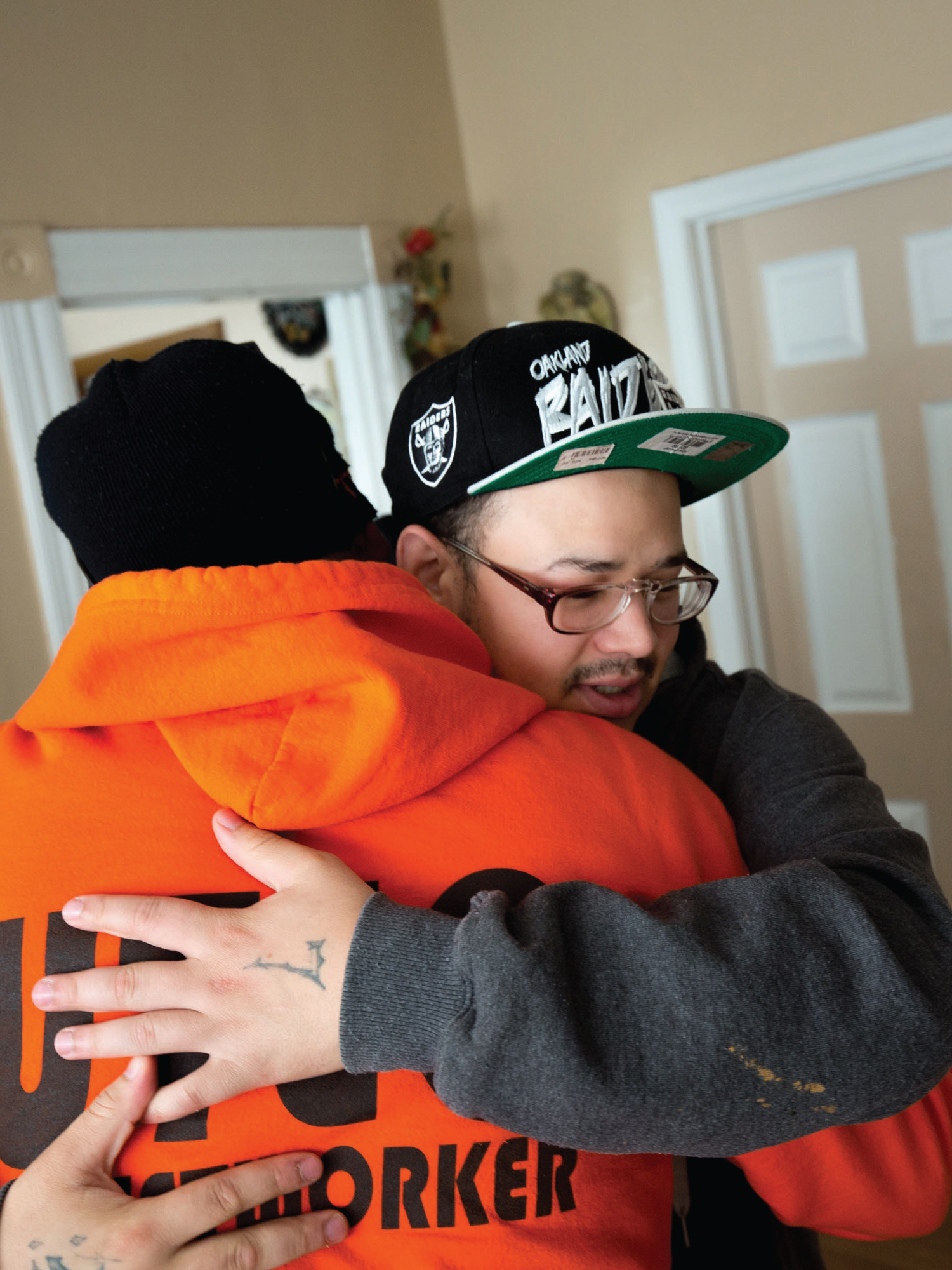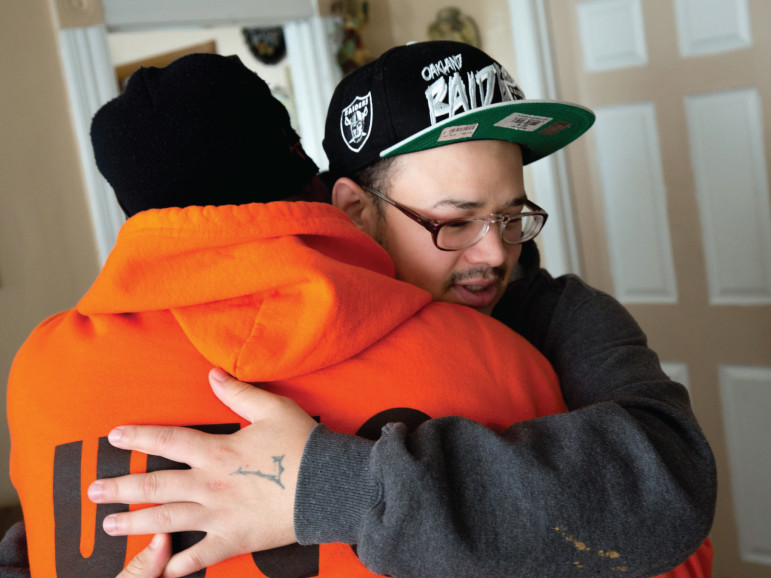
Photos by Justin Saglio
UTEC street worker Johnny Chheng (left) hugs Miguel Vasquez at Vasquez’s home in Lowell, Massachusetts. Vasquez participates in mentorship with UTEC’s street team.
Gang-involved and disconnected youth find new path at nationally recognized program
Jamel Bonilla was 17 when he took part in an armed robbery. He was convicted of a felony and served 18 months in Massachusetts’ Middleton House of Corrections.
Upon his release two years ago, he floated from dead-end job to dead-end job. “I was really down and out. I was near homelessness,” he said.
He was also battling drug addiction.
But staff members of UTEC, a local nonprofit organization in Lowell, Massachusetts, had kept in touch with him. They had visited him in prison.
“I picked up the phone one day, and I just called them,” he said. An hour later, a “street worker” from UTEC, formerly known as the United Teen Equality Center, appeared at his door.
Bonilla credits UTEC for saving him from going back to prison.
UTEC is a comprehensive nonprofit organization that draws in disconnected and gang-involved young people and offers them intensive support as well as jobs in its cafe, catering, furniture-making and mattress recycling services. Young people can pursue a high school equivalency degree while doing these jobs, which also provide a small amount of funding (less than 2 percent of annual income) for the nonprofit.
Some participants go on to take part in UTEC’s youth-led political action efforts, such as a campaign to lower the voting age to 17 in city elections. The center also has a gym, a sound recording studio, event space and offers enrichment activities, with facilities open for drop-ins in the late afternoon.
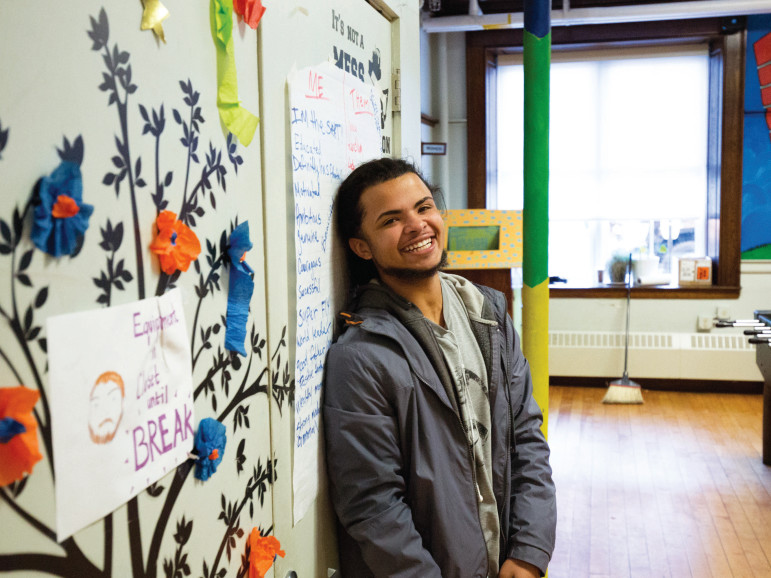
Santiago Andino poses at UTEC headquarters in Lowell, Massachusetts. Andino is being mentored by UTEC staff.
A community response
The organization started in 1999 as a community response to gang crime. Lowell is a city just outside of Boston with more than two dozen gangs. Its poverty rate is twice the Massachusetts average, and it has a diverse immigrant community. As many as 2,000 youth may be gang-involved, including members of rival Cambodian and Latino gangs, according to the Lowell Police Department.
“Young people were really the ones who stood up and said we needed to have a safe haven,” said Gregg Croteau, UTEC executive director. About 20 to 30 high school students and older youth met with adult volunteers, the Downtown Neighborhood Association and the city of Lowell to create the teen center.
The downtown area was a neutral zone for gangs, and the center was intentionally located there. Youth were on the committee that interviewed and hired Croteau to run the center.
Over the years, UTEC has created a combination of services that are unusual and effective. In 2014, 84 percent of the youth in its intensive program did not get rearrested, Croteau said, a rate far better than the 40 to 50 percent prison recidivism rate in the state. More than one-third of participants got their high school equivalency degree while with UTEC, and more than half got jobs outside the organization.
The Robert Wood Johnson Foundation has recognized UTEC as a model in youth violence prevention.
Out in the streets
“Everything kind of started in street work,” said Jonathan Lunde, who manages UTEC’s outreach program. Lunde is one of UTEC’s four street workers who circulate the city and develop relationships with gang-involved kids, young people in prison and others on the edge of trouble.
They focus on outreach, crisis intervention, providing referrals to community resources and gang peacemaking.
Street workers have a relationship with all the gangs in Lowell, from the “soldiers” to the “shot callers,” Lunde said.
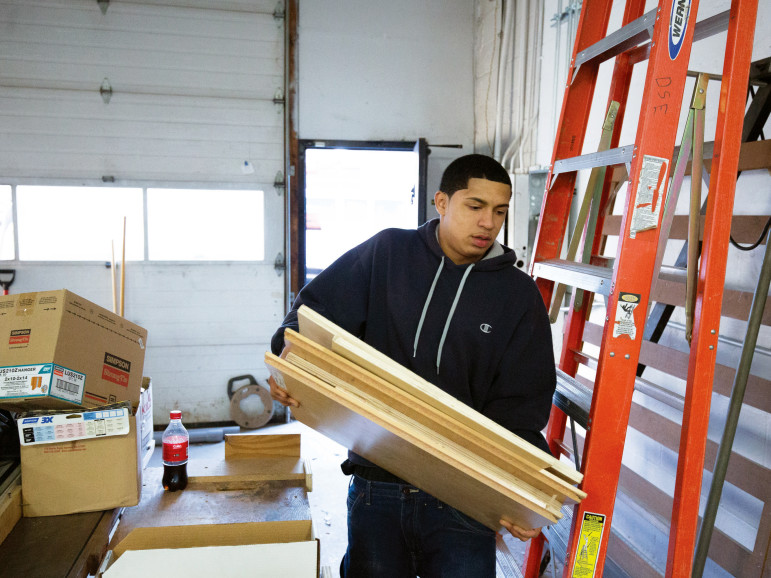
Franklin Diaz moves planks of wood into the under-construction woodworking shop at UTEC headquarters.
They’re aware “anytime something pops off in the city,” he said.
“We position ourselves in the right places,” he said.
Street workers check in with the courts, corrections officers and probation officers.
They go into jails and prisons numerous times each week, build relationships with incarcerated young people and help them immediately upon release from prison.
They are tenacious in maintaining relationships and are ready with support when it’s needed.
Whenever a crisis hits, they see it as an opportunity to reach a young person at a critical point.
“We [might] get a call from the hospital,” Lunde said. A young person got stabbed. “We find out who the young man is.”
“The biggest thing for us is preventing any kind of retaliation,” he said. Street workers work with both sides of any conflict.
This past spring two gangs in Lowell erupted in violence.
“We were able to bring two of the shot callers together,” Lunde said, referring to the gang leaders. Eventually, the two sat down four feet apart in a room with the street workers. They ended by dapping — knocking their fists together to represent agreement and peace making.
In the past year, UTEC has successfully mediated 31 conflicts and taken gang members on eight “peace trips,” in which street workers and gang members spend time together talking, often on out-oftown fishing trips.
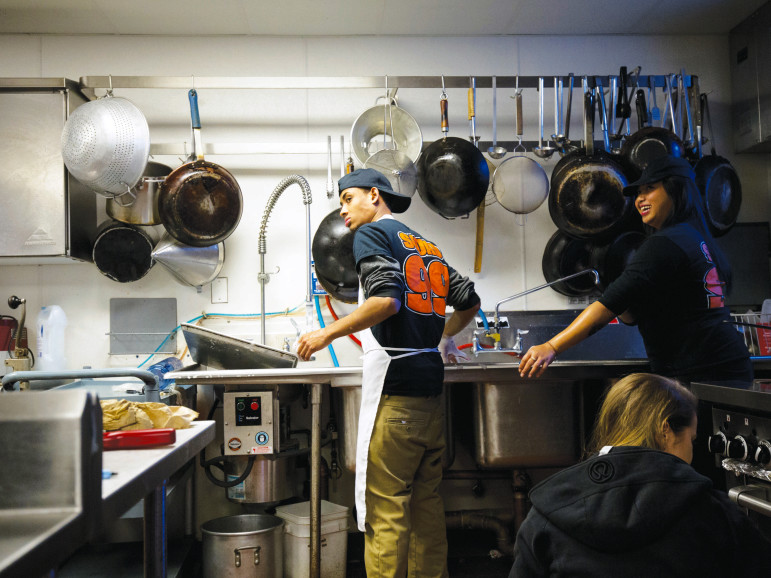
Other young people in the UTEC program work in the kitchen at UTEC or at a mattress recycling plant in Lowell, Massachusetts.
Gang trouble nationwide
Gangs and gang violence exist throughout the United States. Forty-five percent of high school students said gangs were present at their school, according to a 2010 study by the Office of Juvenile Justice and Delinquency Prevention. Thirty-five percent of middleschool students reported a gang presence in their school.
They most commonly recruit in middle schools, and the majority of kids who join a gang do so between ages 11 and 15, according to research published by the National Institute for Justice and the Centers for Disease Control and Prevention.
UTEC targets young people ages 16 to 24, however, seeing a gap in services for that age group. It doesn’t used the terms “at risk” or “high risk,” using the term “impact youth” instead.
They are the 10 percent of the youth population who are responsible for 85 percent of the street activity in Lowell, Croteau said.
They have an impact on the community. And when UTEC works with them successfully, UTEC has the potential of turning a negative impact into a positive one, he said.
In 2014, the organization served 130 young people through its intensive program — and another 500 to 600 through outreach and enrichment activities.
More than three-fourths of the youth in UTEC’s intensive program in 2014 had a criminal history, according to the organization. Nearly half were pregnant or parenting. About one-fourth were female. Forty-three percent were gang-involved.
Street work has been recognized by the U.S. Office of Juvenile Justice and Delinquency Prevention as one of the important practices in gang violence prevention. A comprehensive program model created by the OJJDP to reduce gangs and gang violence spells out strategies shown to be effective.
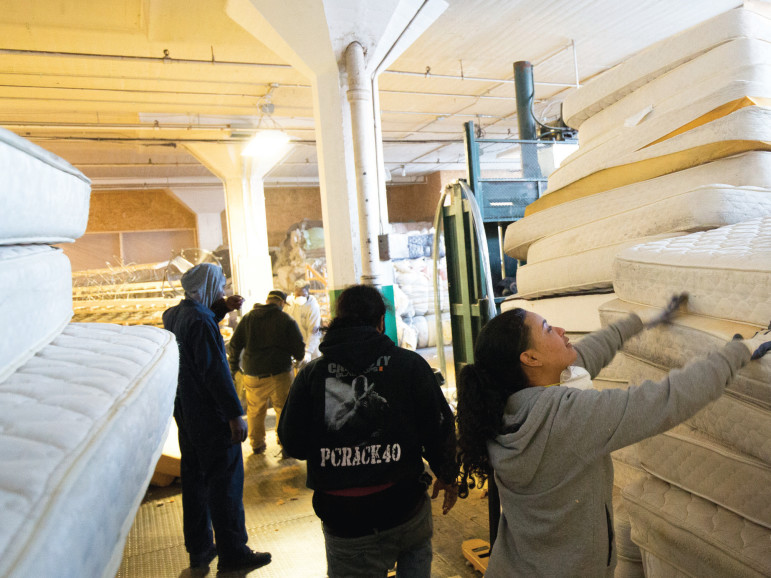
A job at the mattress plant is the first step in a rehabilitation program that brings youth into the workforce.
A comprehensive model
AT UTEC, outreach and gangpeacemaking are only the beginning.
Youth spend an average two to 2½ years in UTEC’s intensive program, generally working a half-day for pay in one of UTEC’s social enterprises and spending a half-day on academics. When they leave to take an outside job, “Transitional coaches stick with the young person two to three years,” Croteau said.
Transitional coaches function as case managers to work with youth on a variety of goals. “Training young people in jobs is key,” he said.
Youth often start by working in the organization’s mattress recycling program, pulling apart mattresses, gaining job skills and income.
Support and friendship
Bonilla, now 22, is working full-time in UTEC’s culinary program, which provides catering services.
“We learn how to work with people,” he said.
“It gets us ready for the future,” he said. The program leads to internships and jobs, he said.
“It keeps us busy, off the streets and out of jail,” he said.
Bonilla recently spoke at a community awards event in Lowell sponsored by Eastern Bank. He talked about the street workers.
“They know where we come from, what we’re about. They’ve been through the struggle,” he said. Some have battled addiction. Others have been in prison.
[Related: Wounded Teen Activist Returns to City Where He Was Shot]
After Bonilla was released from prison, he found the lure of the street very strong. Street life is “fast living,” he said, and it takes a lot of willpower to leave.
Lizmarie Padua, 22, came to UTEC in July.
“I got pregnant with my son,” she said. “I ended up in a shelter.” She didn’t have any help from family members. “
A friend that I knew [in the shelter] introduced me to UTEC” to try to help her get back on her feet. She’s made new friends and said she’s learned a lot.
“I’m here now and feel better,” she said. “It’s been rough.”
Both Bonilla and Padua said people in their lives had given up on them — parents, family, teachers. At UTEC they found adults who have a great deal of patience and who don’t give up, they said.
Never give up
UTEC added the workforce development component to its programming in 2006, employing youth and helping them develop job skills.
“Our social enterprises allow us to create our own rules,” Croteau said. The rules for impact youth initially need to be different than the rules at outside jobs, he said.
“They’re going to test us,” he said of the youth.
The social enterprises — food service, woodworking and mattress recycling — are not second chances for these youth, he said. “We design our programs to be eight or nine or 10 chances,” he said.
“We’ve built in relapse.”
If a young person doesn’t show up for work for a couple of days, a UTEC staff member will be at their door to ask why.
At UTEC, staff members talk about meeting people “where they’re at,” which can mean meeting them at the point of opportunity — when they’ve just been arrested or convicted, for example — and are at a point of change.
Lunde may say to them: “This is where you’re at … but where could you be?” to help them envision other possibilities.
But meeting someone “where they’re at” is also about acceptance.
“A big part of it is not judging,” Lunde said.
“Everybody in life makes mistakes,” he said. Some mistakes are worse than others, he said, and with the most severe ones, you’ll most likely pay a big price.
“But everyone in life needs someone who’s going to be there for them and not judge them,” he said.
Kids don’t get kicked out of UTEC, Croteau said, but “we hold the bar high in accountability.”
“Be relentless,” he said. “Never give up. Keep chipping away.”
The Lowell downtown area was a neutral zone for gangs, and the center was intentionally located there. Youth were on the committee that interviewed and hired Croteau to run the center.
ABOUT UTEC:
Executive Director Gregg Croteau said he didn’t know of a similar organization that had this combination of services — including youth-led policymaking — under one roof.
The model: “UTEC staff want youth to trade violence and poverty for social and economic success.” The nationally recognized model begins with street outreach and gang peacemaking, as street workers establish relationships on the streets and in prisons. The organization then connects youth with alternative education and work experience in UTEC’s social enterprises — a catering business, a cafe, a mattress recycling effort and a woodworking shop. “Coaches” follow the youth for two to three years. A youth-led civic engagement social justice effort connects to all of the programming.
Finances: UTEC has revenue of $4.2 million. Nearly half comes from city, state and federal governments. Foundations contribute more than 40 percent. Sources: Guidestar for latest income figures, and UTEC’s 2013 financials
Scalability and replication: Croteau says the organization developed with the needs of one specific community in mind and isn’t interested in opening additional sites. However, UTEC does want to become a national hub for teaching, learning and policymaking. It already provides trainings to practitioners from other organizations on street work, effective social enterprises, how to build relapse into a program and other topics.
Editor’s note: After publication, representatives from UTEC provided updated figures reported in this story. One-half of participants got their high school equivalency degree while with UTEC, and more than half got jobs outside the organization. Additionally, UTEC’s social enterprises, where young people work, now provide less than 10 percent of the nonprofit’s annual income.
Resources
National Gang Center Bulletin offers a 2010 report by the Office of Juvenile Justice and Delinquency Prevention (nationalgangcenter.gov/content/ documents/bulletin-5.pdf) that includes data and recommendations, such as policies and procedures to prevent gang incidents, that could be applied in the OST setting.
“Changing Course: Preventing Gang Membership” (nij.gov/ publications/changing-course/ Pages/welcome.aspx) is published by the National Institute of Justice and the Centers for Disease Control and Prevention. “Written by some of the nation’s top criminal justice and public health researchers,” NIJ says this book “offers evidence-based principles that can halt the cascading impact of gangs on youth, families, neighborhoods and society at large.”
More related articles:
With Merger and Grant, Wyman Hopes to Expand Work with Underserved Kids
Artistic Collaboration: Transforming Youth and Youth Justice by Integrating Arts
Ferguson Puts Chess in Schools to Help Students


